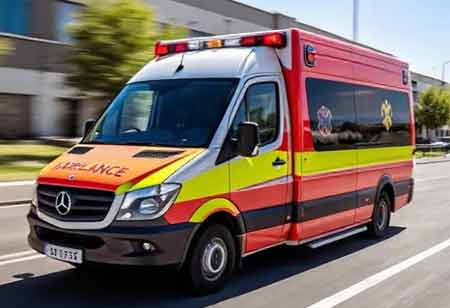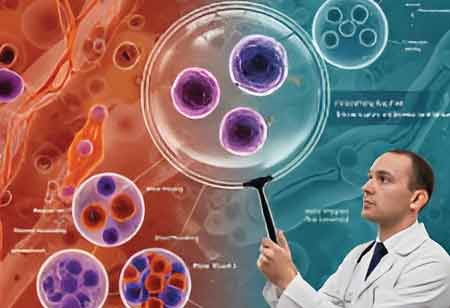Thank you for Subscribing to Healthcare Business Review Weekly Brief
Be first to read the latest tech news, Industry Leader's Insights, and CIO interviews of medium and large enterprises exclusively from Healthcare Business Review
Transforming Ambulance Transport Across Europe
Ambulance transport services across Europe are pivotal in the healthcare infrastructure, providing timely and appropriate medical care in emergency and non-emergency situations.

By
Healthcare Business Review | Thursday, August 21, 2025
Stay ahead of the industry with exclusive feature stories on the top companies, expert insights and the latest news delivered straight to your inbox. Subscribe today.
Ambulance transport services across Europe are pivotal in the healthcare infrastructure, providing timely and appropriate medical care in emergency and non-emergency situations. Advancements in technology, shifts in service models, workforce dynamics, and evolving regulatory frameworks are driving efficiency, effectiveness, and patient-centred pre-hospital care improvements.
Technological Integration and Innovation
By 2025, technology is set to transform ambulance transport services, enhancing operational efficiency and patient outcomes by integrating advanced communication systems, real-time data analytics, and cutting-edge medical devices. Next-generation communication networks, powered by 5G technology, will enable seamless data transmission between ambulances, hospitals, and dispatch centres, facilitating real-time video consultations with remote specialists and improving pre-hospital care through telemedicine capabilities. Adopting data analytics platforms will further optimise resource allocation by analysing historical and real-time data, allowing predictive modelling to anticipate high-risk areas and surges in demand. Decision support systems will also equip paramedics with evidence-based treatment protocols, ensuring consistent and high-quality care. Meanwhile, deploying advanced medical devices—such as portable ultrasound machines, sophisticated cardiac monitors, and automated drug delivery systems—will enable more precise diagnostics and timely interventions in the field. These advancements will redefine emergency medical response, improving efficiency and patient survival rates.
Evolving Service Delivery Models
The traditional model of ambulance transport is evolving to align with the changing needs of the population and the healthcare system. Emerging service delivery models emphasise timely, location-specific, and appropriate care to enhance patient outcomes.
A key development is integrating ambulance services within broader healthcare systems, fostering closer collaboration with hospitals, primary care providers, and community health services. This interconnected approach ensures seamless transitions of care and continuity of treatment. The use of shared electronic health records further enhances coordination, allowing paramedics to access patient medical histories and transmit real-time data to hospital staff, thereby reducing medical errors and improving efficiency.
Additionally, expanding specialised transport services addresses the unique needs of specific patient populations. Dedicated pediatric ambulances, bariatric transport units, and mental health crisis response teams are becoming more prevalent, ensuring patients receive specialised care from trained professionals with the necessary expertise and resources.
Furthermore, community paramedicine programs are extending the role of ambulance services beyond emergency response. By providing in-home assessments, chronic disease management, and preventive care, these initiatives help reduce hospital readmissions and improve overall health outcomes. Community paramedicine promotes patient empowerment and fosters a more proactive approach to healthcare delivery by addressing social determinants of health.
Workforce Development and Training
The ambulance transport workforce is undergoing significant transformation, necessitating continuous training and professional development to adapt to the profession's evolving demands. Paramedic training programs are becoming increasingly comprehensive, integrating advanced medical knowledge, clinical skills, and critical thinking. Simulation-based training is widely utilised to provide realistic scenarios, allowing paramedics to refine their expertise in a controlled environment. Ongoing education ensures they remain current with medical advancements and best practices.
Additionally, paramedics' scope of practice is expanding, enabling them to perform a broader range of medical procedures, including advanced airway management, medication administration, and minor surgical interventions. This expansion requires rigorous training, certification, and oversight to maintain patient safety and care standards.
Recognising the profession's high-pressure nature, there is a growing emphasis on workforce wellbeing and resilience. Targeted programs addressing stress, burnout, and mental health challenges are being implemented, offering peer support networks, counselling services, and mindfulness training. These initiatives are essential in ensuring the sustainability and effectiveness of ambulance personnel in delivering critical emergency care.
Regulatory Frameworks and Standards
Regulatory frameworks and standards are essential in maintaining the quality, safety, and consistency of European ambulance transport services. Efforts to harmonise regulations among European countries are facilitating cross-border cooperation and ensuring a standardised level of patient care through common protocols, equipment standards, and training requirements. Performance measurement systems are also being implemented to track key indicators such as response times, patient outcomes, and customer satisfaction, enabling continuous quality improvement. Accreditation and certification programs reinforce service reliability by providing independent compliance assessments with established safety and quality standards, fostering public trust and confidence in ambulance services.
By 2025, European ambulance transport services will be defined by technological advancements, evolving service models, a highly skilled workforce, and stringent regulatory frameworks. These developments will enhance efficiency, effectiveness, and patient-centred care in pre-hospital medical services, ensuring timely and appropriate treatment. A continuous commitment to innovation, data-driven decision-making, and quality improvement will drive progress in the sector. The seamless integration of ambulance services within the broader healthcare ecosystem will be essential for optimising resource utilisation and improving health outcomes. Achieving these objectives will require sustained collaboration, technology and workforce training investment, and adherence to evidence-based practices. As the healthcare landscape evolves, ambulance transport services will remain a fundamental pillar of the system, playing a critical role in safeguarding public health and well-being.






